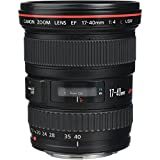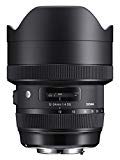Real estate photography can make or break a sale. For many real estate photographers, it all comes down to the lenses they use. Capturing stunning property photos is an art, and the wrong lens can let you down. This page explores some of the best lenses out there.
We also discuss some of the things to look out for when shopping. If you’re a real estate photographer or run your own photography business, make sure you read through this guide. We’re here to help you find the best lens for real estate photography.
Best Lens for Real Estate Photography
In our opinion, these are the best lenses for real estate. They all deliver beautiful, wide-angle images with minimal distortion.
1. Nikon 16-35mm F4G ED
The wide focal range of this lens makes it perfect for real estate photography. You’ll be able to capture the whole room just by standing in the corner. This lens is ideal for houses with a variety of different lighting conditions; the ISO range gives you plenty of flexibility.
Estate agents on the move will appreciate the built-in noise reduction technology which delivers minimal distortion for your shots. The exceptionally high optical performance and picture angle make this an excellent candidate for best real estate photography lens.
Pros:
- Great focal range
- Perfect for real estate photography
- Delivers exceptionally high image quality
Cons:
- The autofocus can be a little slow
2. Canon EF 17-40mm f/4L USM
This is one of the best options for real estate photography both inside and outside the property. The reasonable price tag on this Canon EF comes with plenty of bang for your buck. Canon’s “super UD” glass boosts optical performance and prevents chromatic aberration.
The focal length of 17-40mm provides plenty of wiggle room for wide-angle shots. Real estate photography involves a huge number of different subjects. Estate agents need photographers who can focus in quickly. The ultrasonic motor focus system on this zoom lens makes it easy to produce razor-sharp real estate photos with excellent image quality.
Pros:
- Ultra-wide-angle for beautiful interior shots
- Produces beautiful, high-quality images
- Generous focal length
Cons:
- The shutter speed isn’t the best; it’s a little on the slow side
3. Sony FE 12-24mm f/4G
This ultra-wide lens is built for the Sony full-frame camera range. It’s ideal for real estate photography for a number of reasons. A wide-angle lens makes it easy to capture a room in all its glory. The focal length on this model gives you tonnes of space to work with.
This lens offers a level of quality that’s hard to beat. The nano AR coating, phenomenal autofocus and 7-blade circular aperture deliver high-quality real estate shots every time. This is one of the best options out there for real estate photography.
Pros:
- Stunning full-frame shots
- Ultra-fast autofocus
- Handles different lighting conditions well
Cons:
- Doesn’t play nicely with some third-party filters
4. LAOWA 10-18 mm F/4.5-5.6 FE
This is a great option for real estate photography. The auto and manual focus options here deliver an excellent level of control for your photos. This is another lens on our list with a full-frame field of view. This is a popular choice for real estate photographers, as it makes it easier to capture the full details of a property.
The build quality is excellent and should last through hundreds of property shoots. You may need a Sony lens mount for this one.
Pros:
- High-quality, full-frame shots
- One of our favorite wide-angle lenses
Cons:
- The zoom / aperture rings are a little stiff
5. Sigma 12–24mm f/4 HSM Art
This zoom lens offers a lot of what estate agents are looking for in their photos. Sigma’s lens is ideal for larger, sprawling properties with lots of space to capture. The image quality here is remarkable. The manufacturer promises 0 distortion from the centre of your images right to its very edges.
Distortion is a problem in any photo, but in real estate – it’s enemy number one. Capturing accurate images that celebrate the beauty of a property is made difficult by unwanted distortions. This addition to your kit can be mounted on either a Canon or Nikon camera; just make sure you pick the right model before wasting your money.
Pros:
- Distortion-free real estate shots
- Compatible with either Canon or Nikon
- Huge wide-angle photos
Cons:
- Far from the cheapest option on our list
6. Tokina AT X PRO
The three, ultra-low-dispersion elements on this lens bring a staggering level of color accuracy to your photography. The bright, bold colors in your property will be represented accurately and beautifully. Your wide-angle shots will be crisp and sharp every time thanks to the powerful manual-focusing system.
The aperture range is f/2.8 to f/22, which should give you plenty of flexibility whether you’re taking interior or exterior shots.
Pros:
- Brilliant color accuracy
- A versatile and flexible lens for properties of all sizes
- Truly shines when taking landscape shots
Cons:
- Flares quite easily in direct sunlight
Factors to Consider
Great real estate images can add thousands of dollars to the value of a property. If you’re interested in this type of photography, it’s important you know what to look for. Throwing a thousand bucks at any old lens won’t cut it.
Wide-Angle
You may have noticed that wide-angle lenses rule the roost when it comes to real estate photography. It’s all about making the rooms look as large and spacious as possible. A wide-angle lens will make it easy to capture the whole room without much difficulty. Some models have a frame of view wider than the human eye is able to perceive!
The best lens for real estate snaps is a wide-angle lens.
Zoom Lenses
Rooms come in all shapes and sizes. For this reason, you’ll need a lens for real estate that can adapt to each property. A zoom lens lets you set different focal lengths on the fly without having the fumble around with other lenses. To clarify, a zoom lens and a wide-angle lens aren’t mutually exclusive; one lens can be both.
Tilt-Shift Lens
A tilt-shift lens will allow you to conveniently “crop out” unwanted elements on the fly. Say you’re taking photos of a particular room and a smoke alarm or light fixture is ruining the shot. Using tilt-shift will help you avoid these elements by “tilting” or “shifting” them out of view.
Reduced Distortion
Blurry photos are a huge red flag in real estate photography. If you can’t get clear images of the building, then how are potential buyers supposed to trust what you’re offering? The best lens for this kind of work will deliver minimal distortion on all of your images.
Prime vs Zoom
To understand which of the two is the best lens for real estate photography, it’s necessary to explain what each lens is capable of.
A prime lens is a more compact, lighter option that usually delivers a high level of sharpness and image quality. These are important factors to look for in property photography. The drawback of prime lenses is that they’re fixed at one specific focal length.
This means that if you want to get any closer to your subject, you’ll have to physically move closer while holding your camera. When you consider the number of potential obstacles and limitations that exist from room to room, this is far from ideal
When buying a lens for real estate images, pick an option that can zoom for you. You’ll be able to get gorgeous wide shots and accurate close-up shots without moving from where you’re standing.
Manual vs Auto-Focusing
The choice you make here will depend on the type of photographer you are and the style of photography you value.
If you often find yourself dashing from property to property with no time at all to waste, autofocus is going to matter a lot to you. Using an auto setting will sacrifice some “punch” and detail in favor of speed.
A good camera and lens will focus quickly and accurately. It’s worth mentioning though, that there are a few scenarios where an automatic setting might not be good enough. In low contrast environments, autofocus can fall short, as it struggles to differentiate between objects in the room.
For spaces with a lot of backlighting, some manual tweaking may be necessary. Low light conditions are also not the best for autofocus; images can come out grainy and blurry. If the room you’re shooting is very “busy” with loads of different objects, the auto setting might have trouble deciding what to lock in on.
If you know what you’re doing, manual focus gives you ultimate control over your photography. You want your property pictures to be the best they can be, so tweaking to perfection is worth it if you have the time. The best lens for real estate photography will have great systems for both manual and auto focusing.
Related
Conclusion
A good real estate photographer with the right wide-angle lens can add thousands to a property’s value. Getting this type of photography right is important. The best lens for your real estate images will probably be a wide-angle zoom lens with great distortion-reducing features.
Sony, Canon and Nikon consistently offer good lenses for real estate. Other third-party options do exist, so use the factors we outline in this guide to make an informed decision. Double-check that any lens you consider:
- Handles most light conditions well
- Has a wide field of view
- Can zoom well while maintaining a high resolution
- Can tilt-shift
- Is compatible with your camera
No matter which lens you choose, we hope you have fun shooting with it!



